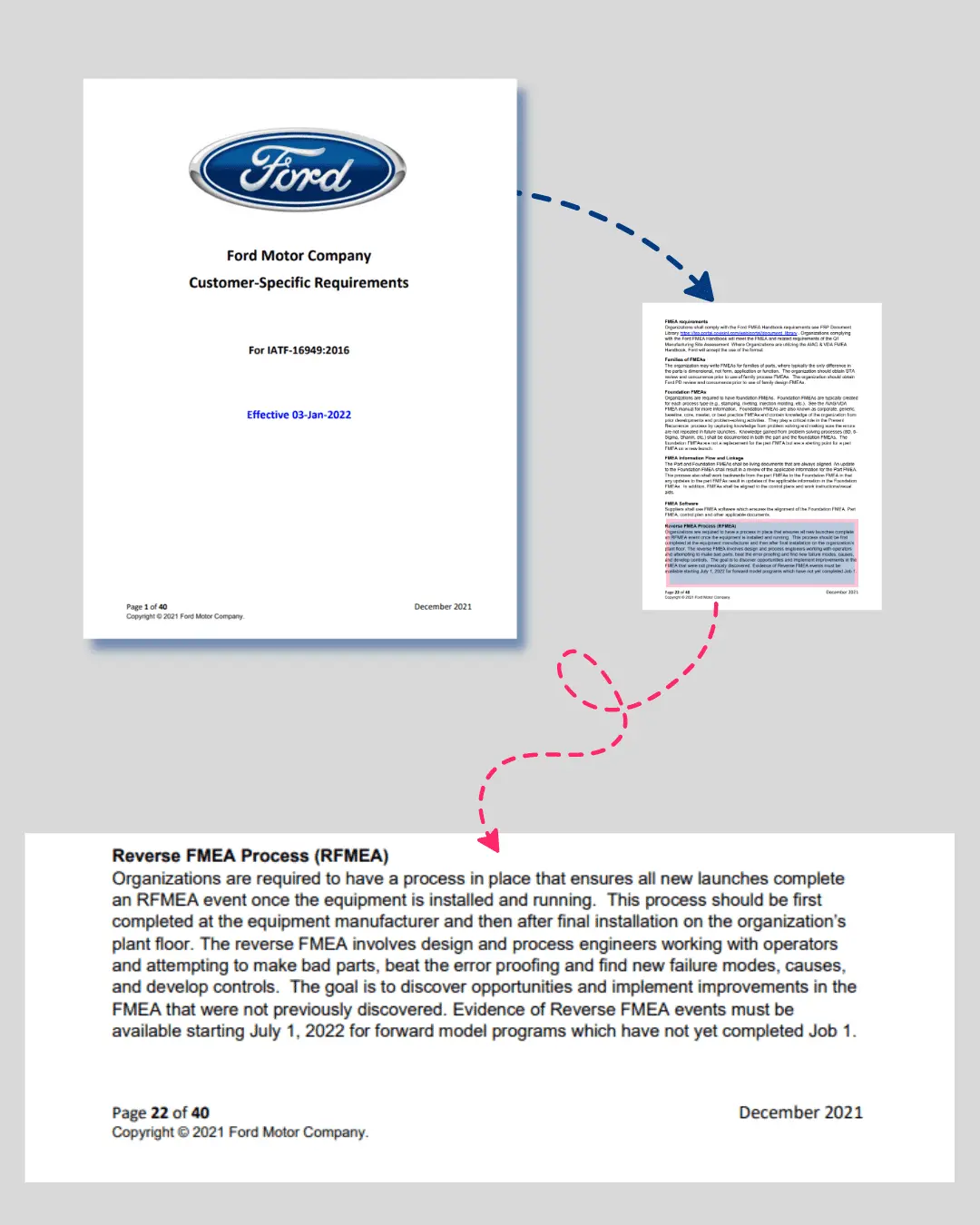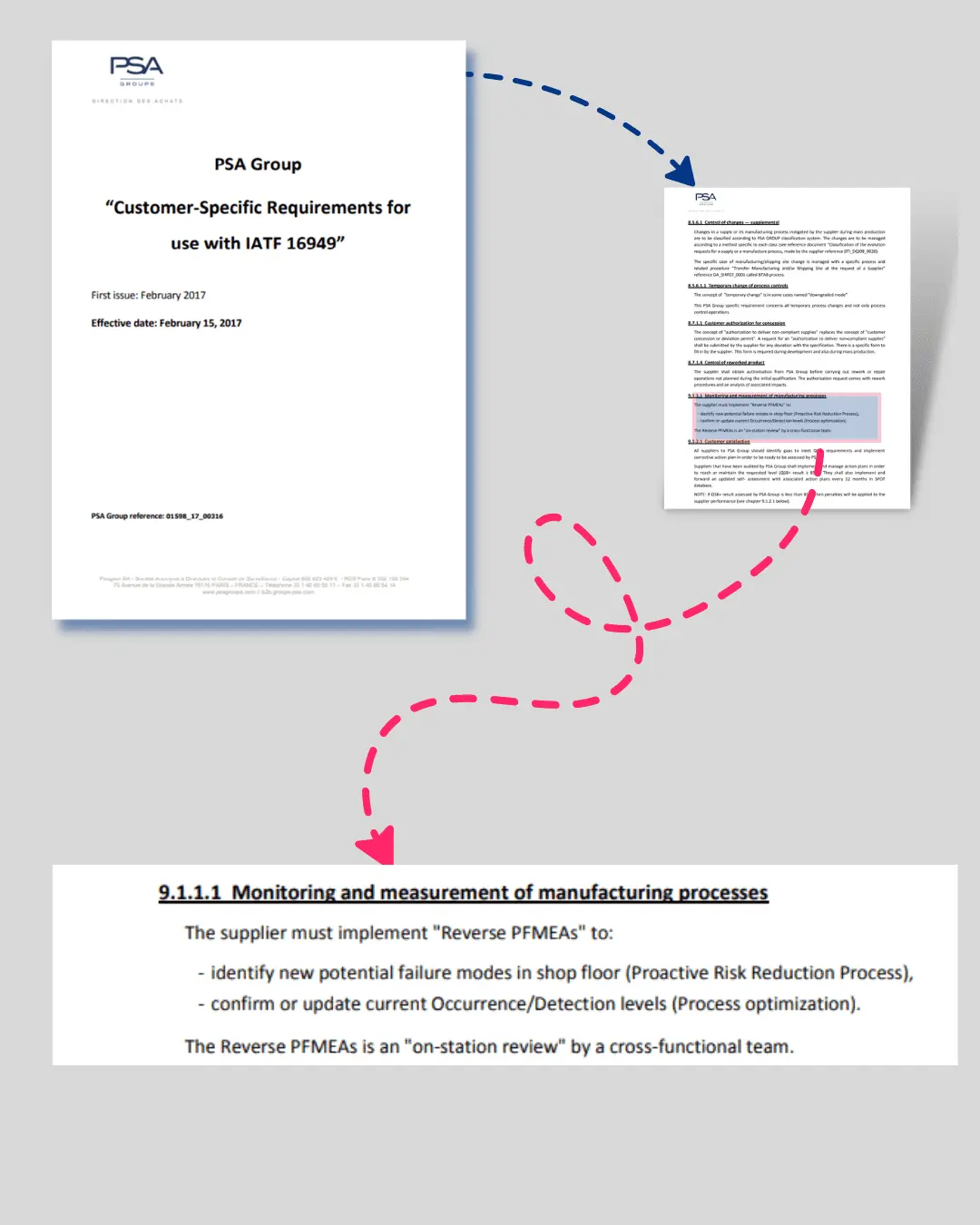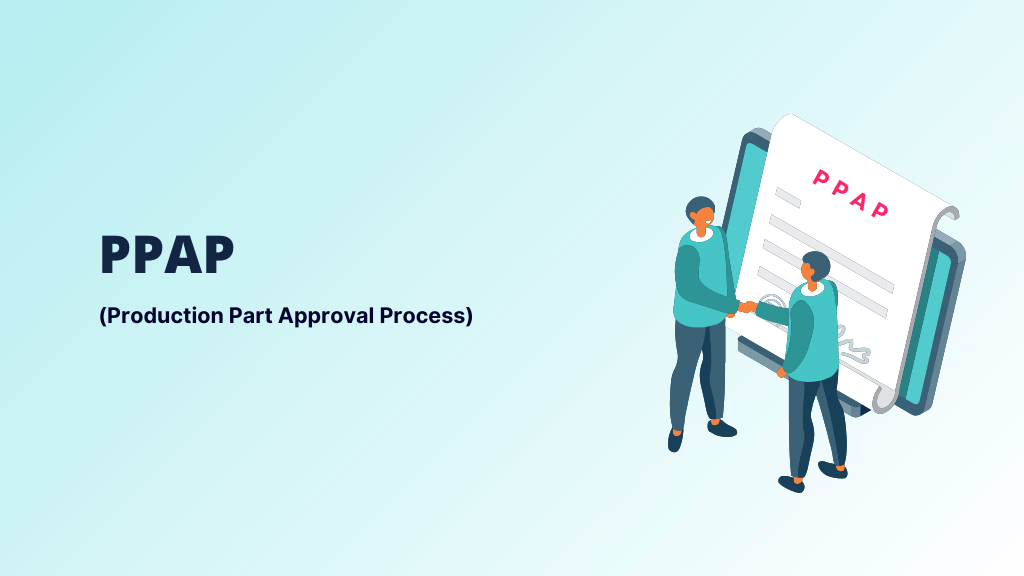Let’s learn about the complete concept of reverse FMEA.
When it’s time for risk assessment, the FMEA (Failure Mode and Effect Analysis) tool is used to identify and reduce the potential risks in design and process.
All OEMs are adopting new methods for continuous improvement and trying to improve product quality.
Thus reverse FMEA is new requirement introduced by many Automotive OEMs. They have added R-FMEA requirement in their CSR and supplier manuals.
The OEMs who introduce this requirement are Groupe Renault, PSA Group, Ford, Stellantis, GM, and many more.
Reverse FMEA requirement by OEMs
Refer below OEMs CSR requirements for RFMEA,
Ford Reverse FMEA requirement

GM Reverse FMEA requirement

Groupe Renault Reverse FMEA requirement

PSA Group Reverse FMEA requirement

So, This article is describing the fundamentals and complete process of reverse FMEA with example.
What is Reverse FMEA?
Reverse-FMEA is the method/tool to review the PFMEA using on-site or shop floor observation.
In this method, the organizations should check their existing FMEA with actual shop floor process. And improve it by identifying new failures and their corrective and preventive actions.
Reverse FMEA method and Steps
Basic Principle of RFMEA is to identify the new failures associated with the actual production process in plant. Then we will update our existing Process FMEA and other supporting documents.
Reverse FMEA is perform as per below steps:
- Define the scope of RFMEA – Workstation/production line / machine selection
- Team formation
- Shop floor review of Process flow and existing FMEA
- Identify additional Failure modes
- Modify and Update the Process FMEA
- Document the information
- Update other supporting documents
- Knowledge transfer
1. Define the scope of RFMEA – Workstation/production line/machine selection
As per customer specific requirement (CSR) we need to make a R-FMEA plan. It should cover all processes. So, the scope must be clear as per plan.
2. Team Formation
Prepare the multidisciplinary team, who all are well aware about the product and process.
Team includes as,

- Design Engineer,
- Process Engineer,
- Quality Engineer,
- Production Engineer and
- the operator who works on the process.
3. Shop floor review of Process flow and existing FMEA
This step includes the several topics as below:

- Compare the actual process flow operations with existing PFC and PFMEA documents.
- Verify all failure modes, Prevention and detection controls of existing process FMEA with the current process on shop floor.
- Check all failure modes using trails. That, those failure modes are real or just added for documentation / not appropriate.
- Check all the prevention and detection control that is relevant and how it is effective in our existing process. On that basis you can change the ratings and controls in Process FMEA.
- Record all the data of failure trail and verification for further documentation.
4. Identify additional Failure modes
Now, observe the process closely by all team members and identify additional risks as per observation.
Some of the failure modes or some other causes can find during the observation of actual process.
So, all these observations should be documented in observation and trail report. It will help to update the FMEA document further.
5. Modify and Update the Process FMEA
After doing these activities the next step is to update and revise the existing Process FMEA.
Below points can be modify after reverse FMEA study:
- Existing failures can be removed if it is not relevant as per teams observation.
- Change in occurrence and detection ratings, base on actual production process controls and their effectiveness.
- Addition of risk, such as any failure modes or causes which was missed during initial FMEA preparation.
- Failure and cause risk can be change as per actual shop floor process, so those risk needs to control. And to reduce the risk we need to update some corrective and preventive action / recommended actions in the Process FMEA.
- If you found any major risk related to design, then Process FMEA needs to update and recommend the design change action to reduce the risk factor.
6. Document the information

All the observations and new findings are to be report and documented base on customer specific requirements.
This information is required when the customer or auditor will be asking for the same. The audit can be internal or external audit.
7. Update other supporting documents
Process FMEA points are the inputs for many other supporting documents in production stage. So, once the Process FMEA updated, all applicable documents need to update.
Below are some documents that can be modify as per the findings:
- Control Plan, Inspection reports, checksheets, etc.
- Work Instruction
- Maintenance Plan
- Contingency Plan
- Other FMEAs (Design FMEA, System FMEA, etc.)
8. Knowledge transfer
All the information related to the existing risk shall be informed to the organization.
This will help to avoid any recurrence of failure in the product and production process.
This activity includes the information transfer or communication made using the lesson learned, best practices, etc.
Reverse FMEA Procedure
Refer below R-FMEA procedure or process summary:

Benefits of Reverse FMEA

There are many benefits of the R-FMEA tool and method, such as:
- It improves product quality by improving the production process.
- Systematic approach to update the Process FMEA
- Reduce cost of quality by identifying and controlling the actual failures of real-life production process.
- Gain customer satisfaction by fulfilling the customer specific requirement and improving their product quality.
Frequently ask questions on Reverse FMEA
It is a continuous improvement tool to review the actual production process with existing FMEA.
To improve the production process to identify and improve actual failures in process and improve product quality.
A multidisciplinary team is involved in reverse FMEA, includes all related functions such as Design Engineer, Process Engineer, Production Engineer, Quality Engineer and operators.
It is done at Gemba, the Actual Production process on shop floor.
It is conducted during the production run / mass production.
As per scheduled plan. Depending on the organization, they create the annual plan and follow the plan.
The team go on shop floor and find out the observation, what actual failure modes can happen in the process and which controls need to address there.
Document all the finding and update relevant documents.






